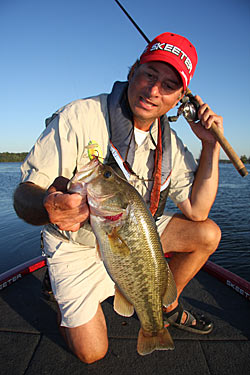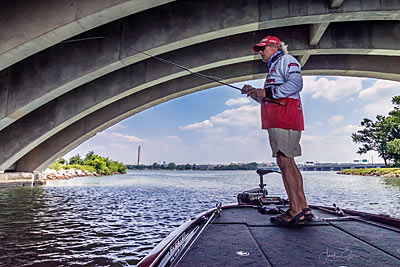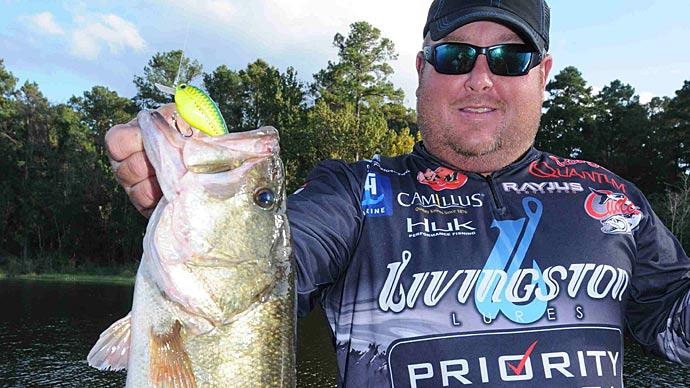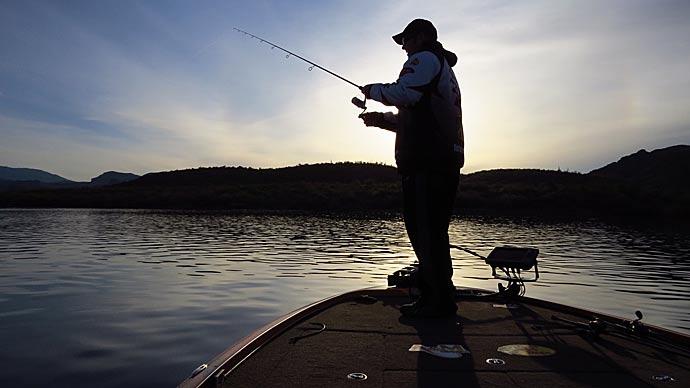
You can argue that a bass is a bass, and the techniques and seasonal approaches for catching them remain the same no matter where you wet your line. That’s unless you’re fishing tidal water, those coastal freshwater estuaries, and rivers where the ocean's pull lowers and raises the water level several times daily. Steve Chaconas discovered the importance of tides a long time ago. “When you fish a place five days in a row, each time under nearly identical conditions, and you only do well once, you realize there’s something bigger going on,” he said.
Chaconas has logged many hours on the Potomac River, the tidal fishery that splits Maryland and Virginia and connects Washington, D.C., with the Atlantic Ocean. He started fishing in the early 1960s and was introduced to the river in the 1980s when he interviewed a professional bass angler as a radio show host during his previous career. That led to a professional change and his current business, National Bass Guide Service. “I’m all about the Potomac,” he said.
Tidal water feels like home to some bass anglers. They seem to possess a sixth sense, knowing when it’s time to change presentation or location. That latter decision confounds many tidal water bass anglers. Do they fish one spot waiting for the tide stage when the bass start biting? Or, do they take advantage of the predictability of tides, running between spots and staying on the best stage?
It’s not an easy decision. “Either way, fishing will be good only about 20 percent of the time with the balance spent waiting or moving,” said George Acord Jr. Acord has logged countless days on the Potomac and nearby upper Chesapeake Bay, which has an equally impressive tidal fishery for bass.
Stay put
Acord and his family operate Susquehanna Fishing Tackle in Columbia, Pa., not far from its namesake river and the Maryland line. Anglers heading to the Chesapeake or Potomac, two of the Northeast’s most famous fisheries, stop there for tackle and the latest fishing reports. Both played roles in his two Bassmaster Classic qualifications (1995 and 2004) through the B.A.S.S. Nation. He looks at the calendar when deciding whether to run several spots or park on one. “The big thing with me is the time of year,” he said.

Tidal water bass spawn in the spring-like their cousins in other bodies of water. That comes with the same dedication to shallow spots where not even the tide can wash them away. Acord is the same way in the spring. “Camping is the way to go,” he said.
Acord targets large grass flats, staying through the changing tide. It’s a move that makes particular sense on mornings when you can catch the last bit of outgoing tide, which is typically considered the best stage. “You can catch your fish,” he said, “and then hopefully pluck out a few more fish before the tide turns again to outgoing six hours later.”
Acord throws moving lures, including a swim jig, swimbait, vibrating jig, and two shallow crankbaits — one for the inside edge of the vegetation and one that dives a little deeper for its outside edge. He also likes to have a flipping bait ready for prime spots.
When Chaconas fishes one spot, he wants a lure that covers the water and lets him know when the bass are ready to bite. It could be a shallow diving crankbait or topwater. But once they start, he switches to a jig.
Camping isn’t only for spring fishing. Chaconas does it most when the water is cold, and bass are hunkered down. In fall, he concentrates on small stretches, 25 to 30 yards long, where he uses 6-pound test to convince bass to bite small hair-jigs or soft-plastic grubs.
Keep moving
Guides become successful one way — by putting clients on plenty of fish. Chaconas falls into this category because he keeps them moving, always on the way to the next hot bite. Some of those happen on spots where other anglers may choose to park. “I’ll be in that spot when I think it’s at its best,” he said.
Acord also takes that approach during summer. That’s when more patterns around aquatic vegetation dominate and bass prefer to feed on certain tide stages.
Chaconas said the Potomac’s bass thrive in its lush aquatic vegetation beds. There are several types, and each demands a different approach. Clumps of milfoil, for example, grow vertically, creating perfect holes for pitching jigs and soft-plastic lures. On the other hand, Hydrilla lays on the surface, forming a mat that’s tough for lures to penetrate. He says it’s best to fish it at low tide when bass are forced to deeper edges.
Chaconas said each aquatic vegetation bed has three edges — outer, inner, and top. He fishes shallower when the tide is high, preferring spots where bass have to stop, such as the edge of a marsh or riprap bank, no matter how far the water rises. It’s the opposite when the water falls. “When the tide goes out, it pulls fish to the edges of the cover — laydowns, aquatic vegetation, or docks,” he said. “It also creates current.”

The amount of current affects fishing as much as the water level. “It can change how the fish bite,” Chaconas said. “In a grass bed, if you have a lot of current, the fish will position behind bigger clumps and wait for baitfish to come by. They roam more and bite less when it’s slack,” he said.
Chaconas follows the tide with his lures. He covers water with a Mann’s Baby 1-Minus crankbait, which runs under the surface, easily bounces off the cover, and snaps free of aquatic vegetation. He uses a drop shot or split shot rig when he wants to fish deeper. Both are thrown on a spinning rod and 20-pound test Gamma Torque braided line. Leaders vary from 6 to 14-pound test fluorocarbon, depending on season and cover. While leaders also are different lengths — about 10 inches for the drop shot and 18 inches for the split shot — both rigs use a 2/0 hook, 3/16-ounce weights, and his hand-poured soft-plastic centipedes.
Acord’s summertime lure selection builds off of what he throws in spring. He adds a frog, buzzbait, and two flipping rods, one with a 3/8-ounce weight and one with a ¾-ounce weight. The latter, which may grow to 1 ½ ounces at the very end of summer, is used for penetrating the thickest vegetation mats.
But spot hopping isn’t always about vegetation. It can be a great approach when bass are in creeks and on hard targets such as individual docks, marinas, and laydowns. Then, Acord likes to present wacky-rigged stick worms on a power drop shop. He ties it with 15 or 20-pound test fluorocarbon, keeping the leader short and hook big. He avoids braided line, believing fluorocarbon’s bit of stretch helps wiggle his stuck lure free, where no-stretch braid would snag it further. When fishing pressure is high or conditions get tough, he switches to a more traditional drop shot, nose hooking, or Texas rigging a finesse worm. “You can’t always be out hunting with big hammer baits,” he said.
Managing the tide
Whether you run or camp, the tide will be part of your game plan. While it's predictable — online tables tell times as far into the future as you’ll ever need — current weather conditions can push it off schedule. More water is moved in less time when the wind blows with the tide, for example, making high or low tide happen earlier. The opposite happens when the wind blows against the tide.
Chaconas said many newer depth finders incorporate tide tables into their display. Select the function in the menu, and when you touch the mapping screen, up pops the time for the next high and low tides at that spot. That’s essential information if you’re staying put, but it’s vital if you’re moving.
Tides happen at different times on the same body of water. High and low tide are later the farther you are from the ocean. For example, if it’s low tide at the Potomac’s Aquia Creek, Acord said he can make a quick run upstream to Mattawoman Creek, where most tournaments launch from, and fish almost the entire last hour of the outgoing tide again. And when it bottoms out there, he can run to Washington, D.C. — about twice as far — and catch the last two hours of outgoing. So, he can fish most of his day at the optimum tide stage with two relatively short moves.
But that’s on a perfect day. The scenario changes depending on where and when during the tide you launch. You may have to sprint upstream to catch the last bit of outgoing, for example, then make a long run downstream to catch it again.
But the tide brings more than good fishing. Chaconas said it can draw in clear or muddy water, depending on rainfall upstream. While the overall movement of water is toward the ocean, each incoming tide delays it, keeping muddy water around and delaying the arrival of clear water. “You have to watch what the tide is bringing you,” he said.




